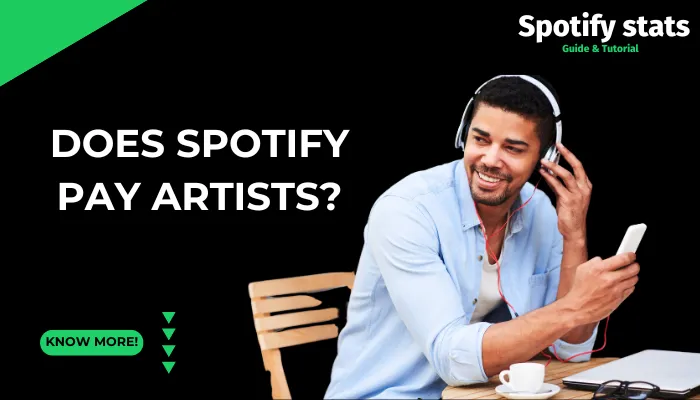For musicians, one question remains unanswered: Does Spotify pay artists? Spotify has completely changed the way we consume music. But musicians and listeners must understand how Spotify pays its artists.
This guide extensively explains how musicians are earning through Spotify, in comparison with other platforms, and suggests ways in which artists can maximize their earnings.

So How Does Spotify Pay Its Artists?
Do millions of streams translate to fame but what about fortune for artists? This part delves into the world of Spotify’s payout. We will unlock the secret behind earnings per stream, discover why it is not as straightforward as it seems, and discuss how agreements with distributors and record companies can affect the final payment. In other words, can individuals get rich through Spotify or does Spotify pay artists? Well, let’s see.
Royalties Per Stream
An artist receives a royalty when you listen to their song on Spotify. This is an over-simplified summary:
- Royalties per stream: Artists earn small amounts every time their songs are streamed.
- Distribution of revenue: That part of your subscription money goes to Spotify, recording labels, and performers of music.
What Determines Payment?
Various considerations may result in different payments per stream that an artist receives:
- Listener location: Payments vary depending on where the listener comes from.
- Subscription type: Premium streams generate more than free (ad-supported) streams revenue.
Calculation of Per Stream Payment
The payment per stream is an average figure that changes in value:
- Average per-stream rate: Between $0.003 and $0.005 per stream.
- Variations: Payments change periodically, in accordance with the above factors.
Elaborate Statement Showing Artist Revenues
To better understand just how much artists make, let us look at the sharing model used as well as calculating each stream earning rate.
Revenue Sharing Model
This is what revenue-sharing model between Spotify, record labels and artists:
| Revenue Source | Percentage |
|---|---|
| Spotify | 30% |
| Record Labels | 55% |
| Artists | 15% |
There are also other ways where Spotify contributes towards its artists.
- Subscription fees: Part of the money derived from premiums paid by subscribers to the Spotify app.
- Ad revenue: Money made from adverts aired on its free version of Spotify.
Artist Payouts on Spotify vs. Other Platforms
Does Spotify pay artists enough compared to other major streaming services in terms of payments to artists?
Spotify is a giant in streaming, although the payout rates can differ greatly depending on which platform you choose. However, knowing this difference is crucial to maximize your music’s earning potential when using platforms with pro-rata versus per-stream models.
So, let’s take a look at how does Spotify stack up against its rivals.
Payment Rates of Spotify vs. Other Platforms
| Streaming Service | Average Per-Stream Payment |
|---|---|
| Spotify | $0.003 – $0.005 |
| Apple Music | $0.006 – $0.008 |
| Amazon Music | $0.004 – $0.006 |
| YouTube Music | $0.00067 |
We will also like to mention advantages and disadvantages for artists earning via streaming platforms.
- Advantages for artists: Wider reach, user-friendly interface, and powerful marketing tools.
- Disadvantages: Lower per-stream rates compared to some competitors.
How Artists Can Maximize Revenue on Spotify
Stil confused about does Spotify pay artists? Yes, Even if it appears hard, musicians can still use different strategies that can enable them to increase their finances through this platform.
Ways to Increase Streams and Revenue
- Effective use of playlists: Being present in popular playlists will tremendously increase the number of listeners who tune into your track.
- Marketing and promotion: Exploit social media and other resources available for promoting your sound.
- Regular releases: The audience wants new stuff, so don’t make them wait much longer than they have to.
Fan Engagement and Social Media Presence
- Engage with fans: Respond to comments, share behind-the-scenes content, and build a personal bond.
- Collaborations: Collaborating with other musicians can help you get seen by a wider audience.
Spotify for Artists Tools and Analytics
- Spotify for Artists: This is an outlet that helps you monitor how well your music is doing, as well as understand the different kinds of people that prefer it.
- Analytics: Analyze data on what songs are doing well and where listeners come from.
Case Studies and Real-Life Examples
Real-life examples will help us understand how Spotify affects musicians today.
Success Stories
- Major artists: Artists like Drake and Taylor Swift have made substantial revenue due to their increased streaming numbers.
- Independent artists: Independent artists who have built a core fan base on Spotify have realized success.
Challenges Faced by Smaller or Independent Artists
- Low earnings: Smaller numbers of streamed songs mean that indie artists do not make much money from this channel.
- Visibility issues: It is difficult to gain visibility without the backing of a major label.
Quotes from Artists
- Positive experiences: According to an independent artist: “Spotify has enabled me to reach out globally.”
- Criticisms: Another artist stated: “The payment rates are too low for the amount of work we put in.”
Controversies and Criticisms
The conversation on artist payouts is a heated one, but millions of artists still depend on streaming platforms such as Spotify. The thing is that Spotify receives some heat from many quarters for the amounts it pays artists per play. We will look into this debate further and consider various angles and suggestions that could possibly be taken up as solutions in future.
Common Criticisms of Spotify’s Payment Model
- Low per-stream rates: Many artists feel that they are not getting paid enough money per stream.
- Transparency issues: Some artists think that there are no clear payments made concerning their tracks.
Responses from Spotify and the Music Industry
- Spotify’s stance: Spotify argues that their model provides exposure and opportunities for all artists.
- Industry perspectives: Mixed reactions from the industry, with some supporting and others criticizing Spotify’s model.
Ongoing Debates and Potential Changes
- Future changes: Discussions about potential changes to improve artist compensation are ongoing.
- Legislation: Some governments are looking into regulations to ensure fairer payments for artists.
Conclusion
So, does Spotify pay artists? Yes it does. However, the fairness of this payment continues to be a subject of debate. While Spotify gives artists a chance to reach out to a global audience, it has low per-stream payouts. This makes it difficult for them to fully sustain themselves on streams alone especially independent musicianship.
Ultimately, there must exist an ecosystem which looks forward to making music last by ensuring thriving artists as well as platforms that distribute their art globally.
